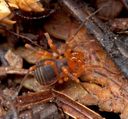Paranonychidae
Paranonychidae
Classification
- Phylum: Arthropoda
- Subphylum: Chelicerata
- Class: Arachnida
- Order: Opiliones
- Suborder: Laniatores
- Superfamily: Travunioidea
- Family: Paranonychidae
Pronunciation
How to pronounce Paranonychidae: /ˌpærəˌnɒnɪˈkɪdiː/
These audio files are automatically generated. While they are not always 100% accurate, they are a good starting point.
Images






Summary
Paranonychidae is a family of armoured harvestmen found primarily in North America, characterized by their preference for forest habitats and diverse genera, with significant ecological roles in their environments.
Physical Characteristics
Armoured body structure typical of harvestmen, with a distinct segmentation between the cephalothorax and abdomen.
Identification Tips
Identification can often be made based on specific genic characteristics such as body shape, color patterns, and the configuration of appendages typical to each genus.
Habitat
Most species prefer well-established forests and are commonly found under superficial woody debris. Some species of Sclerobunus are cave-dwelling.
Distribution
North America, with Metanonychus found in northern California, Oregon, and Idaho; Paranonychus in Oregon and Washington; Sclerobunus in most western states except California and Nevada; and Zuma in California.
Diet
Detritivorous, feeding on decomposing plant matter and fungi.
Life Cycle
Detailed life cycle information is scarce, but like most harvestmen, Paranonychidae undergo an incomplete metamorphosis from egg to juvenile to adult.
Reproduction
Reproductive strategies may include direct sperm transfer and egg-laying, typical of arachnids.
Predators
Their predators likely include various vertebrates and invertebrates that feed on small arthropods.
Ecosystem Role
Paranonychidae play a role in the decomposition process and nutrient cycling in forest ecosystems.
Collecting Methods
- Hand collecting under logs and debris
- Using pitfall traps in forested areas
Preservation Methods
- Ethanol storage
- Drying and pinning specimens
Evolution
Paranonychidae has evolved distinct traits that adapt them to specific ecological niches, especially in forestary environments.
Similar Taxa
- Opiliones
- Triaenonychidae
- Laniatores
Misconceptions
Some individuals may confuse harvestmen with spiders, although they are a distinct order with different biological characteristics.
Tags
- Opiliones
- Arachnida
- Harvestmen
- Paranonychidae
- Ecology